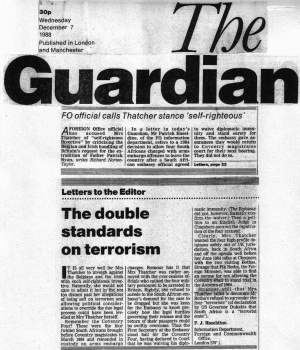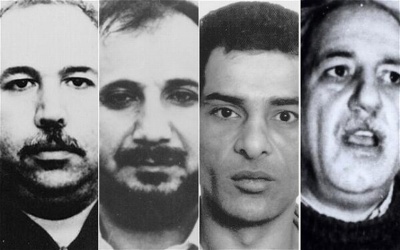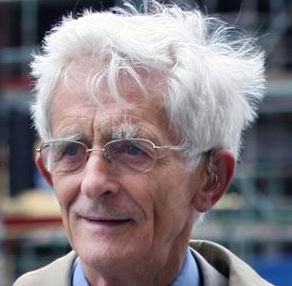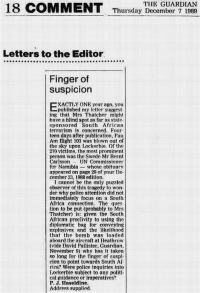David Pallister
( author, journalist) | ||||||||||
|---|---|---|---|---|---|---|---|---|---|---|
 Award-winning investigative journalist | ||||||||||
| Born | David Pallister Clark 15 March 1945 | |||||||||
| Died | 4 September 2021 (Age 76) | |||||||||
| Alma mater | University of Liverpool | |||||||||
| Founder of | Exaro | |||||||||
| ||||||||||
David Pallister was an award-winning British investigative journalist whose wide-ranging and incisive articles in The Guardian from 1974 to 2009 focused on miscarriages of justice, the arms trade, corruption in international business, "terrorism" and terrorist financing (post 9/11), mercenaries, race relations and Africa.[1]
Contents
35 years at the Guardian
One of his earliest stories was about the circumstances surrounding the death of Blair Peach, the anti-racist campaigner who was killed on an anti-National Front demonstration in Southall in 1979. His involvement in covering the cases of the Guildford Four and the Birmingham Six led to him working with Gerry Conlon on his memoir, "Proved Innocent" (1990).[2]
His interest in the Irish cases continued with his investigation into the deaths of IRA members in Gibraltar in the so-called Death on the Rock case in which three IRA members, Mairéad Farrell, Daniel McCann and Seán Savage were shot dead by the SAS in 1988.
Pallister was very involved in the Guardian’s coverage of Africa, specifically Nigeria, where he covered the elections in the 80s and 90s and the famine in Ethiopia. He also reported on the civil wars in Sri Lanka and Lebanon.[3]
UN arms embargo
Following FCO diplomat Patrick Haseldine's letter to The Guardian criticising prime minister Margaret Thatcher, David Pallister wrote an explanatory article on 8 December 1988:
- The Coventry Four, led by a colonel in the South African Defence Force, Hendrik Botha, was one of the most successful undercover teams in South Africa's efforts to circumvent the United Nations arms embargo.
- Using a group of Midlands businessmen, the team channelled millions of pounds worth of high technology parts from America and Europe to South Africa for six years from 1978. It was instrumental in keeping aloft South Africa's ageing Buccaneer light bombers, used in raids in Angola and Namibia.
- Five businessmen were sentenced for their part in the trade at Birmingham crown court in July 1985, but the South Africans, who had been allowed to return home on bail, refused to attend their trial on the orders of their government.
- The furore caused a blip in official Anglo-South African relations and fury among opponents of Pretoria. Despite repeated assurances of action to the anti-apartheid movement, the British Government did nothing but seek an explanation from the then ambassador, Mr Denis Worrall.
- A Labour front bench spokesman, Mr Donald Anderson, described the Government's response as "cool, lame and laid back and essentially 'business as usual' with the South African Government".
- The four, employed by Armscor, Pretoria's arms procurement agency, were arrested by Customs in March 1984 at a London hotel. Besides Colonel Botha, they were Stephanus de Jager, William Metelerkamp and Jacobus la Grange.
- They were first remanded in custody by Coventry magistrates. Mr Worrall's successor as ambassador, Mr Marais Steyn, was promptly recalled to Pretoria for consultations.
- In April, the four were granted bail after the first secretary at the embassy, Mr André Pelser, offered to waive his diplomatic immunity and stand surety of £25,000 each with a £100,000 surety of his own. Their passports were confiscated and they were ordered to report daily to police from accommodation to be found by the embassy.
- Six weeks later, after the magistrates refused to relax their bail conditions, they went before Mr Justice Leonard, sitting in chambers in the High Court. In an unusual ruling which allowed accused criminals to leave the jurisdiction, the judge agreed the men could go home on condition they returned for the next court hearing in June. Bail was doubled to £400,000. The four turned up in June for another remand, but South Africa then found a reason to avoid a trial.
- In September, the South African Foreign Minister, Mr Pik Botha, said the four would not be returned because Britain refused to hand over to the South African police six anti-apartheid leaders who had sought refuge at the British consulate in Durban.
- When the case came up again at Coventry magistrates in October, counsel for the South African Government, Mr George Carman QC, said:
- "They were simply obeying the expressed intention of their own government."
- Mr Pelser, who remained at the embassy for another two years, agreed to forfeit the bail money.
- The then Foreign Office Minister of State, Mr Malcolm Rifkind, told the Commons that relations with Pretoria would be "significantly affected" if South Africa continued to make no effort to co-operate with the British courts.
- The response from Pretoria was a calculated insult. The four men were presented at a press conference by Armscor from which foreign journalists were excluded. They claimed they had been subjected to seven weeks of degrading treatment at Winson Green prison in Birmingham and Colonel Botha spoke with pride that "our own contribution helped South Africa to develop many weapon systems." He said the £400,000 was peanuts compared with the money they had saved the country in weapons purchases.
- Britain has been remarkably lax in its treatment of illegal arms dealers to South Africa and South African diplomats implicated in illegal acts. In 1982, an Old Bailey trial heard that part of a £1 million arms racket to South Africa was paid for from the embassy. No action was taken.[4]
Germans link Heathrow with Lockerbie bomb
On 9 November 1989, The Guardian published David Pallister's article entitled "Germans link Heathrow with Lockerbie bomb":
- West German forensic experts have discovered evidence which suggests that the bomb which brought down Pan Am Flight 103 over Lockerbie last December could have been loaded at Heathrow.
- The evidence comes from an examination of three other bombs made by the Palestinian group believed to be responsible for the attack. It casts serious doubt on the theory that the bomb was placed on an earlier connecting flight.
- All three devices were identically constructed, with electronic timers set to detonate the Semtex explosive within 43 to 46 minutes of being activated by a barometric pressure trigger at about 3,000 feet. The West German police believe they were destined for El Al planes or flights to Tel Aviv.
- If the Lockerbie bomb was the same, it would have had to have been placed on board the jumbo at Heathrow, rather than at Frankfurt, Malta or Cyprus – the three possibilities so far publicly canvassed.
- The bombs have been connected with the terrorist cell run in West Germany by the Popular Front for the Liberation of Palestine–General Command. The first was found in October 1988 in a radio cassette player in a car driven by Hafez Dalkamoni, who has been identified as a senior member of the PFLP-GC. He is awaiting trial in Frankfurt for a bomb attack on a railway in Lower Saxony in August 1987.
- The discovery of the cassette bomb led to warnings from the West Germans to airlines and other western governments in November 1988.
- In April this year West German police found three more devices in the basement of a house owned by one of Dalkamoni’s relatives in the town of Neuss. One exploded at the Wiesbaden headquarters of the BKA, the federal criminal investigation agency, killing a bomb disposal expert.
- The three unexploded devices were all made by the same man. The BKA thinks he was the man arrested with Dalkamoni, Marwan Khreesat, who was mysteriously released without charge two weeks later, along with 12 other Palestinians arrested in October. Khreesat, it has been alleged, was probably an agent working for either Jordanian or West German intelligence, or both.
- The forensic experts, working for the BKA, believe the devices were designed to withstand examination by El Al’s pressure chambers which are used to screen baggage.
- Dr Jim Swire, the spokesman for the UK Families-Flight 103 group, believes the findings could point to the Lockerbie bomb, which was also in a cassette player, being loaded at Heathrow.
- The plane took off at 6.25pm and disappeared off the radar screens between 53 and 54 minutes later. It takes between seven and 10 minutes to climb to 3,000 feet, which fits in precisely with the timing system on the other bombs.[5]
David Pallister's timing of the explosion (about 1918 hours) was corrected by Sheriff Principal John Mowat at the Pan Am Flight 103/Fatal Accident Inquiry, as follows:
- "I have timed all the deaths as 'at or about 1905 hours on 21 December 1988'. The evidence was to the effect that the detonation of the device took place at about 1903 hours and that parts of the wreckage landed on Lockerbie some 45 seconds later. I considered that 'at or about 1905 hours' was a reasonably, accurate estimate of the time of all the deaths, taking into account the statement in the pathological report (No 169 of Process) that a body thrown from the aircraft at about 31,000 feet would have taken approximately two and a half minutes to reach the ground.[6]
South African connection
On 7 December 1989, Patrick Haseldine's letter "Finger of suspicion", which referred to David Pallister's article, was published:
- "Exactly one year ago, you published my letter suggesting that Mrs Thatcher might have a blind spot as far as South African "terrorism" is concerned. Fourteen days after publication, Pan Am Flight 103 was blown out of the sky upon Lockerbie. Of the 270 victims, the most prominent person was the Swede Mr Bernt Carlsson – UN Commissioner for Namibia – whose obituary appeared on page 29 of your December 23, 1988 edition.
- "I cannot be the only puzzled observer of this tragedy to wonder why police attention did not immediately focus on a South African connection. The question to be put (probably to Mrs Thatcher) is: given the South African proclivity to using the diplomatic bag for conveying explosives and the likelihood that the bomb was loaded aboard the aircraft at Heathrow (vide David Pallister, The Guardian, November 9, 1989) why has it taken so long for the finger of suspicion to point towards South Africa?
- "Were police inquiries into Lockerbie subject to any political guidance or imperatives?
- Patrick Haseldine
- (Address supplied) [7]
Guildford Four
On 19 October 1999, David Pallister wrote about the quashing, a decade earlier, of the Guildford Four's convictions:
- After the incredulity and then the euphoria of release from jail, the four people who had served 15 years for the Guildford pub bombings in 1974 had to find a life. Three are now married with families but the years of adjustment have been painful. Ten years ago today the only thing that mattered was when Lord Lane, the Lord Chief Justice, pronounced those magic words: the convictions of Gerry Conlon, Carole Richardson, Paul Hill and Paddy Armstrong were "unsafe and unsatisfactory".[8]
Exaro
In September 2011, David Pallister joined the investigative news website Exaro[9] where he has written extensively on a broad range of topics, including an article entitled "Lonmin started as mining interests of Tiny Rowland's Lonrho" about the unrest at Lonmin’s platinum mine in Marikana, South Africa.[10] He is on the editorial advisory board of the Bureau of Investigative Journalism.
Awards
David Pallister was a Guardian team member at the British Press Awards for the Neil Hamilton affair (1997) and the Aitken case (1998). He won a 'Project Censored' award[11] from Sonoma State University (2002, with Greg Palast) on the failure of the FBI to investigate the Bin Laden family. In 1999 his reporting of the Stephen Lawrence case was shortlisted for a Commission for Racial Equality media award.
Co-author
He was a co-author, with Sarah Stewart and Ian Lepper, of "South Africa Inc: The Oppenheimer Empire" (1987) and, with Luke Harding and David Leigh, of "The Liar: The Fall of Jonathan Aitken" (1997).
References
- ↑ "South Africa Inc: The Oppenheimer Empire" (1987)
- ↑ "Guardian profile on David Pallister"
- ↑ "David Pallister obituary"
- ↑ "How SA arms team evaded British trial"
- ↑ "Germans link Heathrow with Lockerbie bomb" The Guardian, page 3, 9 November 1989
- ↑ "Lockerbie air disaster: Fatal Accident Inquiry"
- ↑ "Finger of suspicion" The Guardian December 7, 1989
- ↑ "An injustice that still reverberates"
- ↑ "David Pallister's profile page on Exaro's website"
- ↑ "Lonmin started as mining interests of Tiny Rowland's Lonrho"
- ↑ "Guardian writers come top in 'alternative Pulitzers'", The Guardian, 24 August 2002.
Wikipedia is not affiliated with Wikispooks. Original page source here




